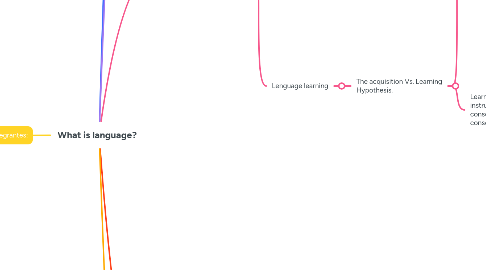
1. Integrantes:
1.1. -Joselyn Estefany Hernandez Perez
1.2. Carlos Alejandro Garcia Pablo
1.3. Joselyn Carolina Argueta Argueta
2. Merriam Webster ́s : a systematic means of communicating ideas or feelings by the use of conventionalized signs, sounds, gestures, or marks having understood meanings.
2.1. What is teaching?
2.2. 1. Ideas or principles taught by an authority. “the teachings of the bible” 2. The occupation, profession, or work of a teacher.
2.2.1. In teacher education programs and in continuing professional development a lot of time is devoted to the ‘what’ of teaching what areas we should cover, what resources do we need and so on.
3. Stiven Pinker: is a complex, specialized skill, which develops in the child spontaneously, without conscious effort or formal instruction, is deployed without awareness of its underlying logic.
3.1. What is learning?
3.2. 1. The acquisition of knowledge or skills through experience, study, or by being taught. 2. Knowledge acquired through experience, study, or being taught.
3.2.1. Learning is a process that:
3.2.1.1. is active - process of engaging and manipulating objects, experiences, and conversations in order to build mental models of the world (Dewey, 1938; Piaget, 1964; Vygotsky, 1986).
3.2.1.2. Builds on prior knowledge - and involves enriching, building on, and changing existing understanding, where “one’s knowledge base is a scaffold that supports the construction of all future learning” (Alexander, 1996, p. 89).
3.2.1.3. requires learners’ motivation and cognitive engagement to be sustained when learning complex ideas, because considerable mental effort and persistence are necessary.
4. Acquisition and learning
4.1. Language acquisition
4.1.1. The process by which humans acquire the capacity to perceive, produce and use words to understand and communicate.
4.1.2. This capacity involves the picking up of diverse capacities including syntax, phonetics, and an extensive vocabulary.
4.2. Acquiring a lenguage
4.2.1. The basic capacity to learn language is innate, while the particular form / meaning connections of individual languages are acquired through prolonged exposure to a specific speech community.
4.2.1.1. Approaches
4.2.1.1.1. Cognitive theory. Jean Piaget (1896- 1980). A child first becomes aware of a concept, such as relative size, and only afterward do they acquire the words and patterns to convey that concept.
4.2.1.1.2. Imitation and positive reinforcement. Children learn by imitating and repeating what they hear.
4.3. Lenguage learning
4.3.1. The acquisition Vs. Learning Hypothesis.
4.3.1.1. Acquisition: the product of a subconscious process that occurs in a natural environment out of the learner’s need to communicate.
4.3.1.2. Learning: the product of formal instruction and it comprises a conscious process which results in conscious knowledge.
4.3.1.2.1. Factors that influence Language Learning
4.3.1.2.2. Motivation comes in two forms:
4.3.1.2.3. Peers and Role Models
5. Theories of Learning & Teaching
5.1. Learning involves change in behavior or in the capacity for behavior. People learn when they become capable of doing something differently. At the same time, we must remember that learning is inferential.
5.2. Learning endure over time This excludes temporary behavioral changes (e.g., slurred speech) brought about by such factors as drugs, alcohol, and fatigue. Such changes are temporary because when the cause is removed, the behavior returns to its original state.
5.2.1. Learning Theory and Philosophy
5.2.1.1. Rationalism Rationalism refers to the idea that knowledge derives from reason without recourse to the senses. The distinction between mind and matter, which figures prominently in rationalist views of human knowledge, can be traced to Plato, who distinguished knowledge acquired via the senses from that gained by reason.
5.2.1.1.1. Empiricism The laws of nature cannot be discovered through sensory impressions, but rather through reason as the mind takes in data from the environment. Unlike Plato, Aristotle believed that ideas do not exist independently of the external world. The latter is the source of all knowledge.
5.3. learning occurs through experience This criterion excludes behavioral changes that are primarily determined by heredity, such as maturational changes in children (e.g., crawling, standing). Nonetheless, the distinction between maturation and learning often is not clear-cut.
6. Theory of Foreign Languages Teaching and Learning.
6.1. What is an Approach?
6.1.1. Is a set of correlative assumptions dealing with the nature of language teaching and learning. It is axiomatic. It describes the nature of the subject matter to be taught.
6.1.1.1. Theory of language: How is language viewed? ‒ Structural View of Language. ‒ Functional View of Language.
6.1.1.1.1. Theory of language learning: How do learners learn the language? – What are the psychological and cognitive processes involved (habit formation, induction, inferencing, generalization)? – What are the conditions that need to be met for these learning processes to be activated?
6.2. What is a Method?
6.2.1. Is an overall plan for the orderly presentation of language material, no part of which contradicts, and all of which is based upon, the selected approach. An approach is axiomatic, a method is procedural. Within one approach, there can be many methods.
6.3. What is a Technique?
6.3.1. Is implementational - that which actually takes place in a classroom. It is a particular trick, stratagem, or contrivance used to accomplish an immediate objective. Techniques must be consistent with a method, and therefore in harmony with an approach as well.
6.4. What is a procedure?
6.4.1. The actual moment-to-moment techniques, practices, and behaviors that operate in teaching a language according to a particular method are termed “procedure”.
